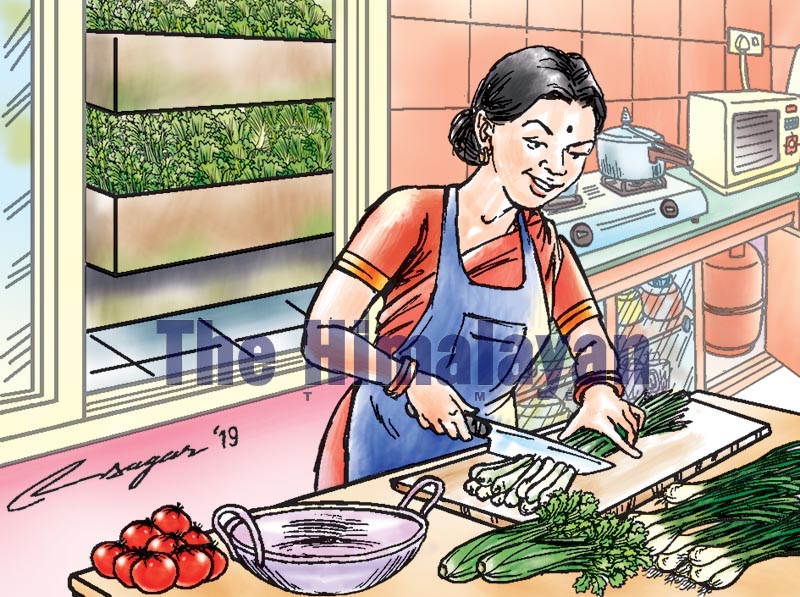Making Kathmandu livable: Climate-smart farming is the key
Rooftop farming has proved to be a viable and innovative method to counter the pollution problem in urban areas. It also helps to secure the food chain as well as to make food locally available
Environmental experts note that the air quality in Nepal’s cities is extremely poor. Cities like Kathmandu face problems of fast urbanisation, population growth, a decline in arable land and climate change. Among the major cities of Asia, Kathmandu suffers from high pollution. Air pollution in the city is above the level considered safe by the World Health Organisation. The air quality is so toxic that it can cause severe health problems, including chronic respiratory diseases. To make Kathmandu city livable, it needs natural sinks, such as green parks or grasslands or food crops on the rooftop of every building. These natural sinks can help absorb the dust and pollution of Kathmandu city.
Climate-smart agriculture (CSA) could be a viable solution to overcome the crisis of air pollution in Kathmandu. Climate- smart agriculture (CSA) is a way of transforming and reorienting agricultural development in the context of climate change. According to the United Nations Food and Agriculture Organisation (FAO), CSA not only enhances crop productivity but also reduces greenhouse gas (GHGs) emissions. It also helps to overcome the issue of food security in the area. CSA is in line with the FAO vision for Sustainable Food and Agriculture and encourages the objective to make agriculture, forestry and fisheries more productive and sustainable.
Climate-smart agriculture has three pillars, namely, productivity, adaptation and mitigation. The first pillar aims to increase agricultural production and incomes sustainably from crops, livestock and fish, without having any adverse environmental impact. Ultimately, this will raise the food and nutritional security of the people. Sustainable crop intensification is the main idea behind increasing crop productivity.
Adaptation aims to reduce the exposure of farmers to short-term risks while at the same time strengthening their resilience by building their capacity to adapt and cope with acute vulnerabilities and stresses. Attention has been paid to protecting the ecosystem services that farmers and others use. Ecosystem services are vital for maintaining productivity and our ability to adapt to climate change.
Mitigation aims to reduce greenhouse gas (GHG) emissions wherever and whenever possible. Avoiding deforestation due to crop production is a mitigation option. Besides, farming techniques must try to manage the soil and trees in ways that maximise their potential to absorb carbon dioxide from the atmosphere.
Climate-smart agriculture includes urban greenhouses, rooftop farming (RTF), indoor and vertical farms. These farming methods have proved to be a viable and innovative method to counter the pollution problem in urban areas. Also, they help to secure the food chain as well as to make food locally available. Among the different CSA technologies, rooftop farming (RTF) that is organic has been reported to be a viable and innovative option for pollution reduction and carbon dioxide absorption in the Kathmandu Valley. Besides reducing pollution, using rooftops to grow vegetables could supplement vegetable supply in the valley.
House owners in Kathmandu do not have much space or farms to plant vegetables and are reliant on the street vendors, mini-marts and roadside groceries to meet their daily requirement. The rooftops or balcony and terraces are the only remaining spaces in their house, which could be utilised for farming and making their surrounding green. Vegetables such as coriander, garlic, chili, onions, tomatoes and other seasonal vegetables can be grown on the roofs and balconies of houses in clay pots and plastic containers. Rooftop organic farming would also solve the issue of pesticide residues in vegetables as the products are free of chemicals.
However, rooftop farming demands inputs of both civil and architectural engineering in house design. Firstly, before turning the roof of the house into farmland, the roof and the condition of the concrete must be inspected to see if it is scientifically and technically waterproof and good for farming. The building inspection should be done by a civil engineer. Secondly, the design of the roof is also an essential aspect of rooftop farming. Water scarcity could be a major challenge for rooftop farming. Thus, technology for rainwater harvesting on the roof and irrigating the plants is a sustainable way to counter this challenge.
A training package for the house owner involved in rooftop farming on vermicompost preparation, waste segregation, nursery management and protection measures is a prerequisite for its sustainability. Rooftop farming and urban greenhouses have not gained momentum yet in the country. Motivational support as well as government policy could bring about the desired momentum in RTF technology. The house owner adopting RTF technology could be awarded in many forms, such as tax reduction in electricity or rental tax reduction. Moreover, a sustained, coordinated effort among the multi-stakeholder agencies, such as the Ministry of Agriculture and Livestock Development (MoALD), Ministry of Urban Development, Kathmandu Metropolitan City, Nepal Agricultural Research Council (NARC), agricultural universities and various non-governmental organisations is required to give impetus to urban rooftop greenhouses in Kathmandu.
Joshi is plant protection officer at MoALD






